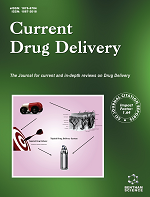- Home
- A-Z Publications
- Current Drug Delivery
- Previous Issues
- Volume 16, Issue 1, 2019
Current Drug Delivery - Volume 16, Issue 1, 2019
Volume 16, Issue 1, 2019
-
-
Breaking the Barrier of Cancer Through Liposome Loaded with Phytochemicals
More LessCurrently, the most important cause of death is cancer. To treat the cancer there are a number of drugs existing in the market but no drug is found to be completely safe and effective. The toxicity of the drugs is the key problem in the cancer chemotherapy. However, plants and plant derived bioactive molecule have proved safe and effective in the treatment of cancers. Phytochemicals that are found in fruits, vegetables, herb Read More
-
-
-
Insights on the Use of Nanocarriers for Acne Alleviation
More LessAuthors: Sandra S. Amer, Maha Nasr, Wael Mamdouh and Omaima SammourAmong the common myths in the cosmetics industry is the perception that acne only happens to teenagers, and specifically to females. However, acne is neither limited to a specific age, nor to a certain gender, it creates a stressful problem for many people. Many chemical treatments for acne were proven to be successful, but when administered as such, they showed many adverse effects, starting from itching to skin dry Read More
-
-
-
Aspects of Nanomaterials in Wound Healing
More LessWound infections impose a remarkable clinical challenge that has a considerable influence on morbidity and mortality of patients, influencing the cost of treatment. The unprecedented advancements in molecular biology have come up with new molecular and cellular targets that can be successfully applied to develop smarter therapeutics against diversified categories of wounds such as acute and chronic wounds. Howev Read More
-
-
-
Controlled Release of Doxycycline by Magnetized Microporous MIL53(Fe); Focus on Magnetization and Drug Loading
More LessAuthors: Shakiba Naeimi and Hossein FaghihianBackground: In this research, MIL-53(Fe) was magnetized and the performance of the magnetized material as a drug delivery system for doxycycline was studied. Objectives: The experiments were designed to load the magnetic delivery compounds with different amount of the drug. Methods: The in vitro release rate of doxycycline from magnetic MIL-53(Fe) with different drug content into saline buffered fluid (SBF, pH Read More
-
-
-
Nose to Brain Delivery of Galantamine Loaded Nanoparticles: In-vivo Pharmacodynamic and Biochemical Study in Mice
More LessAuthors: Sunena, Shailendra K. Singh and Dina Nath MishraBackground: Presence of blood brain barrier is one of the major hurdle in drug delivery to brain for the treatment of neurological diseases. Alternative and more effective drug delivery approaches have been investigated for the drug targeting to brain in therapeutic range. Objective: The present investigation was carried out to improve the galantamine bioavailability in brain by intranasal drug delivery through thiolated chi Read More
-
-
-
A New Therapeutic Approach for Brain Delivery of Epigallocatechin Gallate: Development and Characterization Studies
More LessBackground: Blood-brain permeability is the primary concern when dealing with the biodistribution of drugs to the brain in neurological diseases. Objective: The purpose of the study is to develop the nanoformulation of Epigallocatechin gallate (EGCG) in order to improve its bioavailability and penetration into the brain. Methods: EGCG loaded Solid Lipid Nanoparticles (SLNs) have been developed using microemulsification meth Read More
-
-
-
Development of Biodegradable Injectable In situ Forming Implants for Sustained Release of Lornoxicam
More LessAuthors: Ruby Christian, Vaishali Thakkar, Tushar Patel, Mukesh Gohel, Lalji Baldaniya, Purvi Shah, Tosha Pandya and Tejal GandhiObjective: The focus of this study was to develop in situ injectable implants of Lornoxicam which could provide sustained drug release. Methods: Biodegradable in situ injectable implants were prepared by polymer precipitation method using polylactide-co-glycolide (PLGA). An optimized formulation was obtained on the basis of drug entrapment efficiency, gelling behavior and in vitro drug release. The compatibility of the Read More
-
-
-
Fabrication and Characterization of Electrospun Nanofibers for the Modified Release of the Chronobiotic Hormone Melatonin
More LessObjective: Aiming at the modified release of melatonin (MLT), electrospun-MLT loaded nanofibers, filled into hard gelatin and DRcapsTM capsules, were used as formulants. Methods: Cellulose acetate, polyvinylpyrrolidinone and hydroxypropylmethylcellusose (HPMC 2910) were used for the preparation of the fiber matrices through electrospinning. The in vitro modified release profile of MLT from the fabricated matrices in ga Read More
-
-
-
Improved In vivo Effect of Chrysin as an Absorption Enhancer Via the Preparation of Ternary Solid Dispersion with Brij®L4 and Aminoclay
More LessAuthors: Sang H. Lee, Yeo-song Lee, Jae Geun Song and Hyo-Kyung HanBackground: Chrysin is a strong inhibitor of breast cancer resistance protein (BCRP) but it is practically insoluble in water. Effective solubilization of chrysin is critical for its pharmaceutical application as an absorption enhancer via inhibition of BCRP-mediated drug efflux. Objective: This study aimed to develop an effective oral formulation of chrysin to improve its in vivo effect as an absorption enhancer. Method: Solid dispersio Read More
-
Volumes & issues
-
Volume 22 (2025)
-
Volume 21 (2024)
-
Volume 20 (2023)
-
Volume 19 (2022)
-
Volume 18 (2021)
-
Volume 17 (2020)
-
Volume 16 (2019)
-
Volume 15 (2018)
-
Volume 14 (2017)
-
Volume 13 (2016)
-
Volume 12 (2015)
-
Volume 11 (2014)
-
Volume 10 (2013)
-
Volume 9 (2012)
-
Volume 8 (2011)
-
Volume 7 (2010)
-
Volume 6 (2009)
-
Volume 5 (2008)
-
Volume 4 (2007)
-
Volume 3 (2006)
-
Volume 2 (2005)
-
Volume 1 (2004)
Most Read This Month
Article
content/journals/cdd
Journal
10
5
false
en

Most Cited Most Cited RSS feed
-
-
Preface
Authors: Deng-Guang Yu and He Lv
-
- More Less

